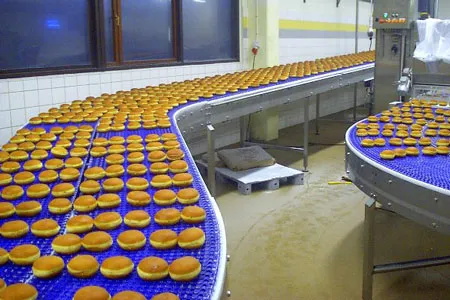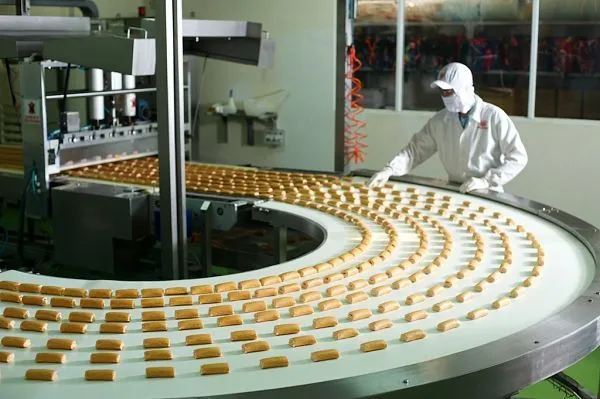Mục lục
Food processing and packaging requires a lot of material handling. Raw materials and finished products need to be transported over long distances in hygienic conditions. Food processing plants used to rely solely on manual labor to perform these functions, which took up a lot of time and money.
But increasing levels of automation, including the use of food handling conveyors, have revolutionized these operations. We will explore how food conveyor systems have made a difference in the food industry by improving quality, production efficiency and worker safety.
But increasing levels of automation, including the use of food handling conveyors, have revolutionized these operations. We will explore how food conveyor systems have made a difference in the food industry by improving quality, production efficiency and worker safety.
What is a food conveyor?
Food conveyors are specialized in transporting food products that ensure food safety and hygiene with a simple, easy-to-clean design. The conveyor belt is specially designed with a 304 stainless steel frame, the conveyor belt surface uses standard PU belt, the food conveyor system ensures the quality of food during the transportation process.
With Japanese standard quality, the food industry conveyor belt operates smoothly without causing shock, minimizing food damage, especially vegetables, tubers, fruits... One type of conveyor belt used in food is the drying conveyor belt to dry products in the agricultural industry, vegetables and fruits, ensuring long-term storage of products in the warehouse.

Food conveyor belt characteristics:
- The conveyor belt structure is simple, easy to install, easy to operate, convenient for conveying many types of products in the production line.
- The conveyor belt operates stably, low noise, suitable for all working environments.
- Low energy consumption helps businesses save costs.
- Food conveyor belts are non-stick and always clean, ensuring food safety.
Top 5 types of food conveyors commonly used today
Food processing conveyors can be customized to meet any food industry requirement. Food conveyor systems that meet washdown requirements help food manufacturers meet hygiene regulations. Some examples of food conveyors
- Fruit conveyors
- PVC conveyors for transporting milk
- Seafood processing conveyors
- Inclined food conveyors
- Food drying conveyors
Here are the types of food conveyors commonly used today:
1 - Pneumatic conveyors
Pneumatic conveyors use an air pressure system to move materials through pipes. These conveyors are ideal for handling powders and granules, as well as materials that are difficult to move with other types of conveyors. Pneumatic conveyors are also easy to clean and maintain, making them a popular choice in the food industry.
2 - Belt Conveyors
Belt conveyors for warehouses or food processing use a continuous belt to transport materials horizontally or incline. They are versatile and can handle a wide range of materials, including both bulk and packaged goods, which is why they are widely used in many industries. The material being transported does not move on the conveyor, meaning it is not damaged during transport.
3 - Bucket Conveyors
Bucket conveyors use a series of buckets to lift materials vertically or, less often, move them horizontally. They are often used to move materials to higher levels, such as when moving grain to a storage silo. Bucket lifts are capable of handling a wide range of materials, including both bulk and packaged goods.
4 - Screw Conveyor
Screw conveyors use a rotating spiral inside a tube to move material along a horizontal or inclined path. They are typically used to move material over short distances, such as when moving material from one processing plant to another. Screw conveyors are ideal for transporting feed, meat, and similar materials. However, they should not be used to transport fragile materials.
5 - Tubular Drag Conveyor
Tubular drag conveyors use a series of discs placed along a sealed cable to move material through a sealed tube. These conveyors are ideal for transporting fragile materials in the food processing industry because they minimize handling and contact with the material
They are also energy efficient, easy to clean and maintain, and extremely flexible in terms of layout and space. The closed tube design helps keep raw materials sealed, reducing the risk of contamination and making it an excellent solution for food processing facilities.
Conveyor applications in the food processing industry
The advent of food conveyors also helps the food industry meet increasing regulations that require more hygienic conditions as food is handled less.
- Manufacturers use food conveyor systems to move:
- Raw materials from warehouses to processing areas
- Finished products on packaging lines
- Packaging goods to shipping areas
Top 7 benefits of Food Processing Conveyors
Increasing automation in food conveyor systems has benefited the food industry, in addition to improving environmental sanitation. Food manufacturers who have installed conveyors have realized many advantages. Some of the key benefits include:
1 - Higher production rates
As in any industry, automation increases productivity. In the food industry, food processing conveyors allow bulk foods to move faster so operations can process more food in less time.
2 - Improved worker safety
With the implementation of food conveyor systems, workers no longer need to move heavy objects over long distances. This eliminates one of the main causes of worker injuries.
3 - Reduced Labor Costs
More food-handling conveyors mean fewer workers are needed to complete tasks. This reduces labor costs, including not only wages and benefits, but also hiring, training, and maintenance.
4 - Fewer Errors
Because they are automated, food-grade conveyor systems will always deliver the right product to the right place, minimizing the possibility of human error.
5 - Improved Compliance with Quality Standards
Using food-grade conveyors reduces the possibility of contamination and breakage, allowing manufacturers to more easily maintain quality standards.
6 - Increased Flexibility
Both the speed and direction of material flow can be varied on food-grade conveyor systems, making conveyors a versatile addition to food processing operations. The modular design of conveyors also means that they can be reconfigured to meet changing production requirements.
7 - Better Compliance with Food Safety Regulations
When it comes to the food industry, strict hygiene standards need to be met to ensure that final products are fit for human consumption. Advances in conveyor technology have helped more and more facilities comply with these regulations. Belt conveyors allow for a safer and cleaner environment with less dirt build-up that can lead to food contamination.

A guide to effective Food Conveyor cleaning and maintenance
Regularly scheduled cleaning and maintenance is essential to ensure that food conveyors are performing at their best and to prevent the spread of contaminants. There are several steps that should be taken as part of a regularly scheduled food conveyor cleaning and maintenance:
- Disassemble and wash each food conveyor part:
The food conveyor should be disassembled and washed individually with hot water and disinfectant. This helps remove dirt, dust, or other contaminants that may have accumulated on the conveyor.
- Lubricate moving parts:
Any moving part on a food grade conveyor should be lubricated as needed to ensure smooth operation and prolong the life of the conveyor.
- Check food conveyor for wear:
During maintenance, it is important to inspect the food processing conveyor for signs of wear, such as cracks, rust, or other damage. Any damaged parts should be repaired or replaced as needed to ensure the conveyor operates safely and efficiently.
- Perform regular scheduled food conveyor maintenance:
Regularly scheduled cleaning and maintenance is key to ensuring that food conveyors are performing at their best and preventing the spread of contaminants. It is important to establish a regular cleaning and maintenance schedule and stick to it to ensure that conveyors are being properly cared for.
In addition to preventing the spread of contaminants and maintaining the cleanliness and hygiene of the production process, regular cleaning and maintenance of conveyors has several other benefits:
- Improved efficiency
- Extended service life
- Improved product quality
- Improved worker safety
Important considerations for choosing a Food Conveyor System
How can you be sure you are using the right conveyor? Here are a few things to look for to help you choose the right food conveyor for your food industry:
- Hygienic design:
Due to the high level of safety regulations surrounding food production equipment, machinery in food processing operations needs to be designed to reduce the risk of food contamination. Hygienic conveyors are typically made from stainless steel, can withstand high-powered washdowns, and can be easily cleaned to prevent bacterial growth.
- Easy to washdown:
Choosing a conveyor that can be easily cleaned is an important element of complying with strict food hygiene guidelines.
- Safety features:
With any type of production equipment, safety is always a primary concern. Conveyors designed with safety features suitable for the food industry can significantly reduce incidents to products and operators.
- Durability:
Conveyors should be designed and installed with high durability so that they can withstand even the most demanding processing environments. The conveyor must be able to run for many hours continuously with high stability.
- Low maintenance:
Ensuring that your conveyor is low maintenance and will not require frequent repairs is an important consideration to get the most out of your conveyor.
- Suitable conveyor belt:
The types of products that need to be handled are different, so choosing the right type of belt is necessary to create the highest efficiency when using it.
Current food conveyor price quote
The price of a food conveyor depends on many factors, including its size, material, capacity and specific features. Therefore, there is no specific price that applies to all types of food conveyors.
The price of a food conveyor can range from 50,000,000 to billions of VND, depending on the above factors. To know the exact price of a food conveyor, you should contact the conveyor manufacturers directly to receive detailed information and quotes.
Food Conveyor Belt manufacturing company address
As a leader among conveyor system manufacturers, Intech Group has the expertise, knowledge, and experience to design food and beverage conveyor systems that are right for your application, whether your operation involves fruits, meats, vegetables, convenience foods, dairy, frozen foods, baked goods, etc.
When we design your custom food conveyor system, we take into account many design considerations, including available space, the type of food being conveyed, the travel speed required, and the height and distance the food must cover. Specifications may include drive locations, throughput, rated speed, load capacity, and frame configuration.
Contact Intech today for an estimate on a food handling conveyor that will overcome your toughest challenges.
- Address: Lot 6, Lai Xa Industrial Park, Tay Tuu Ward, Hanoi City
- Phone: 024 66 806 795
- Website: http://intechvietnam.com/






